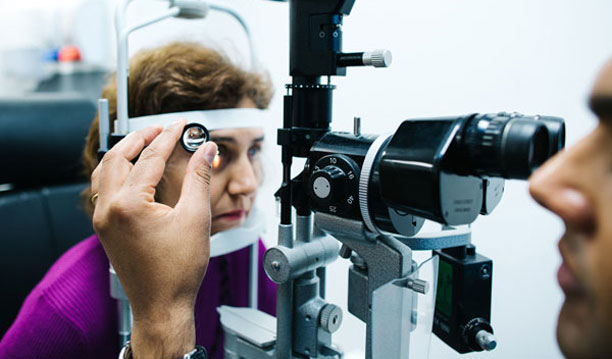Laser Glaucoma
There are 3 types of laser for Glaucoma:
- Peripheral Iridotomy
- Selective Laser Trabeculoplasty
- Cyclodiode
Each type of laser is used for a different type of Glaucoma.

Peripheral Iridotomy (PI)
PI is a procedure which involves using a laser to create a small hole in the iris to help the circulation of fluid within the eye.
PI is advised when a patient is at risk of developing acute angle closure or angle closure glaucoma. Patients who are at risk of developing these forms of glaucoma have what is described as a “shallow anterior chamber”, which is when the space at the front of the eye (between the cornea and the iris) from which fluid in the eye normally drains out from, is narrowed, and at risk of closing off completely. Acute angle closure occurs when there is a sudden closure of this drainage space and typically results in severe eye pain, blurred vision, very high eye pressure and is an emergency situation. Angle closure glaucoma occurs when there is a more gradual narrowing of this drainage space and causes a moderate rise in eye pressure that can cause progressive damage to the optic nerve and lead to loss of vision. In both cases, PI can prevent these events from occurring.

How is PI laser given?
- The treatment is carried out in the outpatient clinic, using a laser machine similar to the slit-lamp that is used to examine patients’ eyes.
- A drop of Pilocarpine is instilled 30 minutes prior to the procedure to help prepare the eye.
- A drop of local anaesthetic is then applied and a contact lens is placed on the eye to help the doctor focus accurately on the iris.
- Normally, 1 or 2 brief laser shots are required to create the necessary opening in the iris. Patients will hear a slight “cracking” sound of the laser machine as the shots are applied.
- Usually, both eyes are treated at the same visit.
- A drop of Iopidine is instilled to help prevent any immediate eye pressure rise.
- The eye pressure is checked 30 minutes after the procedure.
- Patients are given steroid eye drops to use for 1 week after the procedure.
- Patients are reviewed again after 1 week.
What are the risks of PI laser?
PI laser is a common procedure and is highly effective in preventing sight threatening glaucoma.
The small risks of complications include inflammation in the eye, raised eye pressure, localised cataract formation, glare and rarely double vision.
Selective Laser Trabeculoplasty (SLT)
SLT is a simple, effective laser procedure that reduces eye pressure. It works by applying a low energy laser to the drainage system of the eye, and helps to increase the amount of fluid that is removed from the eye.
Who can benefit from SLT?
SLT is appropriate in patients who have:
- Newly diagnosed glaucoma or ocular hypertension
- Patients already on drop therapy, but still have raised eye pressure
- Patients who are intolerant of glaucoma drop therapy
How is SLT given?
- The treatment is carried out in the outpatient clinic, using a laser machine similar to the slit-lamp that is used to examine patients’ eyes.
- A drop of local anaesthetic is then applied and a contact lens is placed on the eye to help the doctor focus accurately on the drainage system at the front of the eye.
- Normally, 100 brief laser shots to the drainage system are required. No pain is felt during the procedure and the procedure takes 5-10 minutes to complete.
- The eye pressure is checked 30 minutes after the procedure.
- Patients are reviewed again after 1 month.
What are the risks of SLT?
SLT is a safe procedure and the risks are minimal. However, patients should be aware of the following:
- Some patients (up to 20%) may not respond and it is not possible to predict who will not respond.
- The benefits of treatment may wear off after several years, however the laser can be repeated.
- Some patients may experience some redness, eye pain or blurred vision for a few hours/days after treatment, but this normally self resolves.
- Occasionally, the eye pressure may rise immediately after the procedure and eye drops may be needed to control this. Very rarely, the eye pressure may remain high and additional procedures are required to reduce it.
Please see this video by Ellex, illustrating the potential benefits of SLT therapy.
Cyclodiode laser
Cyclodiode is a procedure where an external laser is applied the ciliary body, which is responsible for producing fluid in the eye. It is indicated in patients who have painful, end-stage glaucoma in or advanced glaucoma where surgery is not possible.
How is Cyclodiode laser performed?
- Cyclodiode laser is performed in the operating room as a day case procedure.
- A local anaesthetic injection is given around the eye
- Approximately 20-30 laser shots are applied to the eye using a special probe that is placed on the surface of the eye. The procedure usually takes 5-10 minutes.
- Steroid eye drops are given for 1 week after the procedure and patients are advised to continue with their normal Glaucoma medications.
What are the risks of Cyclodiode laser?
Cyclodiode laser is a safe and effective procedure. However, patients should be aware of the following potential complications prior to undergoing treatment:
- Hypotony (too low eye pressure)
- Inflammation in the eye
- Retinal or choroidal detachment
- Thinning of the eye
- Bleeding in the eye

Receive Laser Glaucoma in Hertfordshire…
Venki Sundaram is a trusted Consultant Ophthalmologist. If you would like to find out more about this procedure, get in touch today and visit one of our Hertfordshire clinics.

